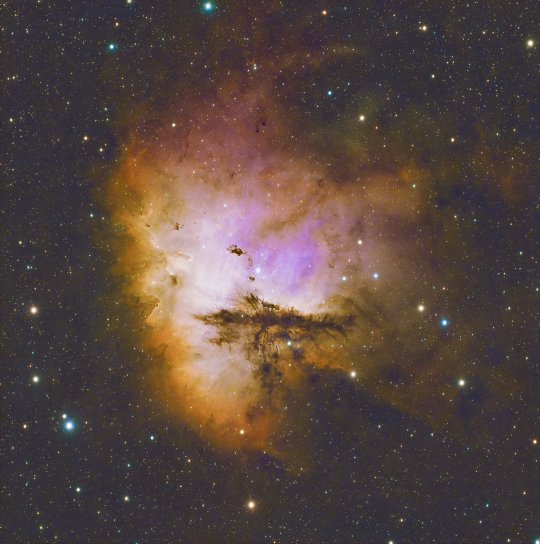#ngc 281
Photo

NGC 281 the Pacman Nebula © Chandra
#nebula#chandra observatory#space#ngc 281#universe#astrophotography#galaxy#pacman nebula#planet#astronomy#planets#cosmos#solar system#stars#night sky
1K notes
·
View notes
Text
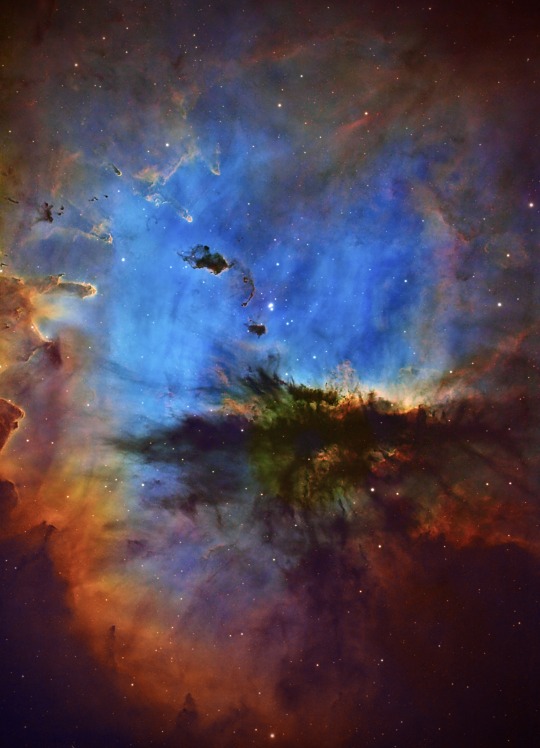
The Pacman Nebula, NGC 281 // Richard McInnis
#astronomy#astrophotography#nebula#emission nebula#star-forming region#pacman nebula#NGC 281#IC 11#Sh2-184#cassiopeia
269 notes
·
View notes
Text

NGC 281, Stardust
4K notes
·
View notes
Text

SPACEMAS DAY 24 ✨🪐🌎☄️☀️🌕
Merry Christmas Eve everyone 🎄🎅🏻☃️❄️🥰
Formed within the nebula cataloged as NGC 281, are the stars of open cluster IC 1590. The cluster's young, massive stars ultimately power the pervasive nebular glow. The eye-catching shapes looming in the featured portrait of NGC 281 are sculpted dusty columns and dense globules seen in silhouette, eroded by intense, energetic winds and radiation from the hot cluster stars. If they survive long enough, the dusty structures could also be sites of future star formation. Called the Pacman Nebula because of its overall shape, NGC 281 is about 10,000 light-years away in the constellation Cassiopeia. This sharp composite image was made through narrow-band filters. It combines emission from the nebula's hydrogen and oxygen atoms to synthesize red, green, and blue colors. The scene spans well over 80 light-years.
Image Credit & Copyright: Craig Stocks
#astronomy#space#science#universe#spacemas#day 24#cassiopeia#nebula#star cluster#light year#stars#nebular glow#Pac-Man#Pac-Man nebula#follow#like#reblog#the first star#the first starr#thefirststar#thefirststarr#nasa#apod#tumblr#blog#space blog#constellation#Christmas Eve#merry Christmas
76 notes
·
View notes
Photo

2023 August 28
Star Formation in the Pacman Nebula
Image Credit & Copyright: Craig Stocks
Explanation: Look through the cosmic cloud cataloged as NGC 281 and you might miss the stars of open cluster IC 1590. Formed within the nebula, that cluster's young, massive stars ultimately power the pervasive nebular glow. The eye-catching shapes looming in the featured portrait of NGC 281 are sculpted dusty columns and dense Bok globules seen in silhouette, eroded by intense, energetic winds and radiation from the hot cluster stars. If they survive long enough, the dusty structures could also be sites of future star formation. Playfully called the Pacman Nebula because of its overall shape, NGC 281 is about 10,000 light-years away in the constellation Cassiopeia. This sharp composite image was made through narrow-band filters. It combines emission from the nebula's hydrogen and oxygen atoms to synthesize red, green, and blue colors. The scene spans well over 80 light-years at the estimated distance of NGC 281.
∞ Source: apod.nasa.gov/apod/ap230828.html
107 notes
·
View notes
Photo

Bok Globules in NGC 281 by Hubble Heritage
964 notes
·
View notes
Photo
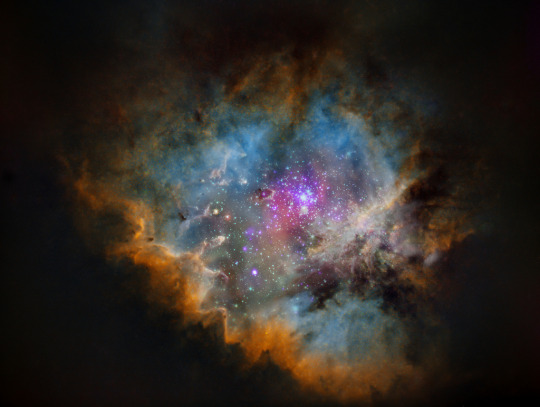
NGC 281: Starless with Stars : In visible light the stars have been removed from this narrow-band image of NGC 281, a star forming region some 10,000 light-years away toward the constellation Cassiopeia. Stars were digitally added back to the resulting starless image though. But instead of using visible light image data, the stars were added with X-ray data (in purple) from the Chandra X-ray Observatory and infrared data (in red) from the Spitzer Space Telescope. The merged multiwavelength view reveals a multitude of stars in the region's embedded star cluster IC 1590. The young stars are normally hidden in visible light images by the natal cloud's gas and obscuring dust. Also known to backyard astro-imagers as the Pacman Nebula for its overall appearance in visible light, NGC 281 is about 80 light-years across. via NASA
656 notes
·
View notes
Text

𝑻𝒉𝒆 𝑷𝒂𝒄𝒎𝒂𝒏 𝑵𝒆𝒃𝒖𝒍𝒂
This composite image of the star cluster NGC 28 contains X-ray data from Chandra, in purple, with infrared observations from Spitzer, in red, green, blue. NGC 281 is known informally as the Pacman Nebula because of its appearance in optical images.
651 notes
·
View notes
Photo
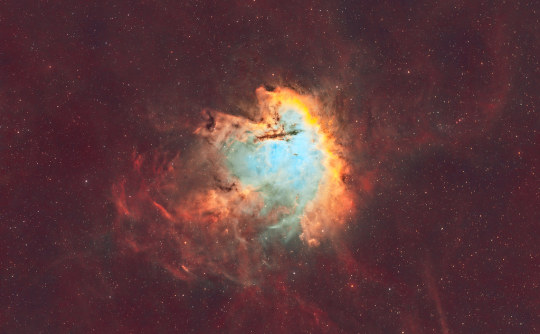
NGC 281 - The Pacman Nebula by Antoine Grelin https://flic.kr/p/2o2TQRp
78 notes
·
View notes
Photo
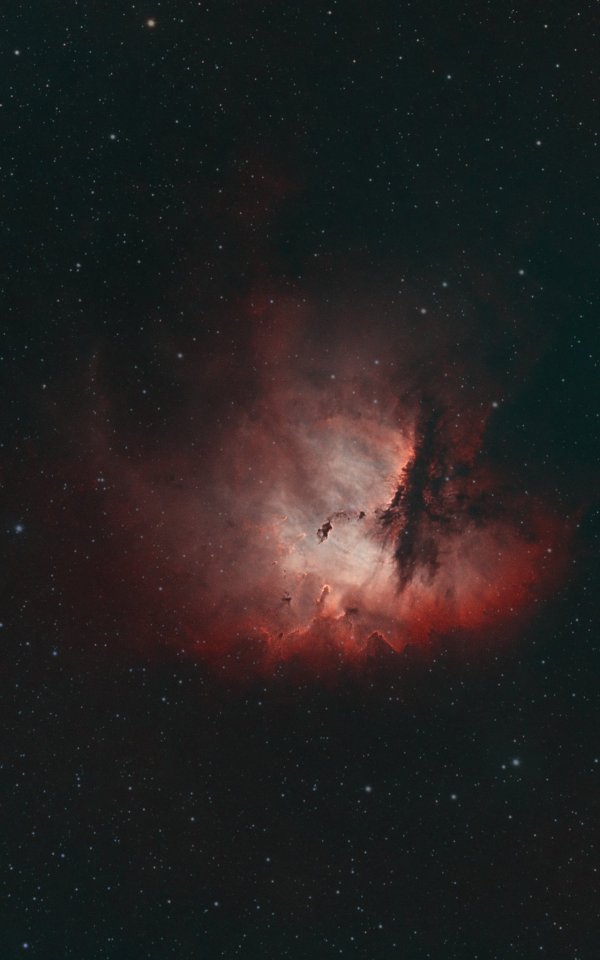
Pacman in Cassiopeia © Robert Leach
#nebula#space#pacman nebula#universe#astrophotography#astronomy#nasa#planet#galaxy#stars#planets#night sky#solar system#ngc 281
2K notes
·
View notes
Text

The Pacman Nebula, NGC 281 // Adam Dudko
#astronomy#astrophotography#nebula#emission nebula#star-forming region#pacman nebula#NGC 281#IC 11#Sh2-184#cassiopeia
106 notes
·
View notes
Text
Arviana Week (Day 6)
@arvianaweek
(sorry for the lateness, I had to do a lot of research...)

Okay, so as I was looking at the stars of Cassiopeia, I noticed a couple of small nebulas below the constellation; the Pacman and Dolphin Nebula.
In this [Alternate Universe]...
Since Arven's thing was cooking with healthy ingredients, I've figured that his Nebula Task Force is "NGC-281". His outfit resembles the Mediterranean chef's uniform, the Uva Academy logo, and the colors of the Pacman Nebula.
My HC for Juliana was that she never felt right using male pronouns. Her Pokemon team never cared about that, all they cared about was her well-being (also in her past life, she had a deep connection with Pokemon via "Poke-tongue"). With that in mind (and the fact that dolphins share a "collective consciousness", I believe it makes sense for her to be a Nebula Task Force of "SH2-308".
The two would often visit each other at their bases and send messages to each other to lift each other's spirits. They would also make each other's lunches.
[For the accents, I used some of my old nail polish and wooden toothpicks.]
3 notes
·
View notes
Photo

NGC 281: Starless with Stars
Credits: Wido Oerlemans, Chandra, Spitzer
22 notes
·
View notes
Photo

NGC 281, Stardust
#Astronomy#NASA#Night#Sky#Stars#Space#Science#Universe#Cosmos#Cosmic#Solar System#Starburst#Stardust#Nebula#Galaxy#Constellations#Constellation#Rainbow#Bright
2K notes
·
View notes
Text
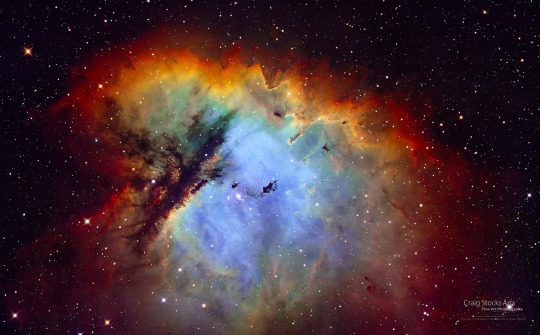
Inside the cosmic cloud cataloged as NGC 281 and you’ll find the stars of open cluster IC 1590. Formed within the nebula, the cluster’s young, massive stars ultimately power the nebular glow. The eye-catching shapes looming in the portrait of NGC 281 are dusty columns and dense silhouettes of Bok globules, eroded by intense winds and radiation from the hot cluster stars. If they survive long enough, the dusty structures could also be sites of future star formation. Otherwise known as the Pacman Nebula because of its overall shape, NGC 281 is about 10,000 light-years away in the constellation Cassiopeia. This sharp composite image was made through narrow-band filters. It combines emission from the nebula's hydrogen and oxygen atoms to synthesize red, green, and blue colors. The scene spans well over 80 light-years.
Image Credit & Copyright: Craig Stocks
#astronomy#space#science#universe#nebula#star#cluster#star cluster#colours#star formation#star birth#Pac-Man#Pac-Man nebula#light years#light year#starry sky#wind#radiation#follow#like#reblog#the first star#the first starr#thefirststar#thefirststarr#nasa#apod#tumblr#blog#space blog
66 notes
·
View notes
